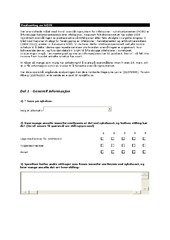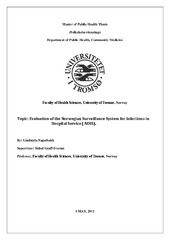| dc.description.abstract | Healthcare-associated infections are a major concern in health care throughout the world, and public health institutions answer to the problem by implementing nationwide surveillance systems. The Norwegian Surveillance System for Infections in Hospital Service (NOIS) was implemented in 2005 to monitor surgical site infections in patients having undergone any one of the most common surgical procedures: Coronary artery bypass surgery, caesarean section, hip replacement surgery, colon surgery, and cholecystectomy. Patients are monitored for these infections through hospitalization plus a period of time after discharge, at which time they stay in touch with the hospital by letter or telephone for follow-up. The NOIS system has not been objectively evaluated since its inception. According to guidelines from the Centers for Disease Control and Prevention (CDC,) the following system attributes of a public health surveillance systems are to be periodically evaluated: Simplicity, flexibility, data quality, acceptability, representativeness, timeliness, stability and usefulness. These attributes are investigated here. A questionnaire survey was constructed and distributed to 52 hospitals of Norway, assessing these attributes through the infectious disease control personnel at the hospital, with a response rate of 69.2% (36 of 52). Hospital routines and practices have been assessed, and representatives from the Norwegian Institute of Public Health (NIPH) have been interviewed to create a complete picture of the functions and benefits of NOIS.
Results: In general, NOIS appears to be working well for hospitals as well as for NIPH. However, four in ten hospitals reported that the use of NOIS caused no change in clinical practice,. The hospital staff deems that their resources are too limited to prioritize training and education in NOIS activities, that the system would benefit from being electronically automatized as far as possible, that the NIPH websites could be improved, and that the annual reports from NIPH should be published sooner after the survey periods, while NIPH public health officials find that hospitals often submit their surveillance results too late.
Conclusion: Although the NOIS surveillance has obvious benefits in the control of surgical site infections, there is considerable room for improvement in its operation at all levels. It is also indicated that NOIS ought to be evaluated on a regular basis. | en |


 English
English norsk
norsk

